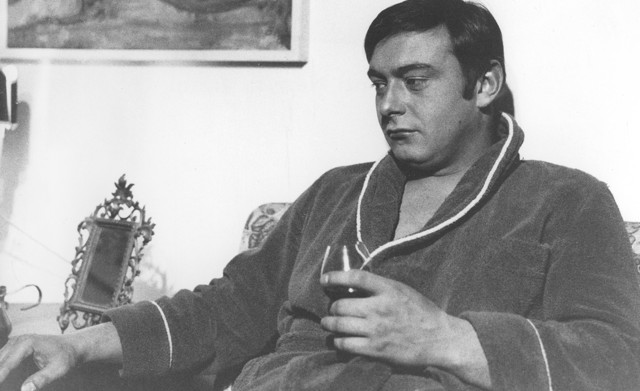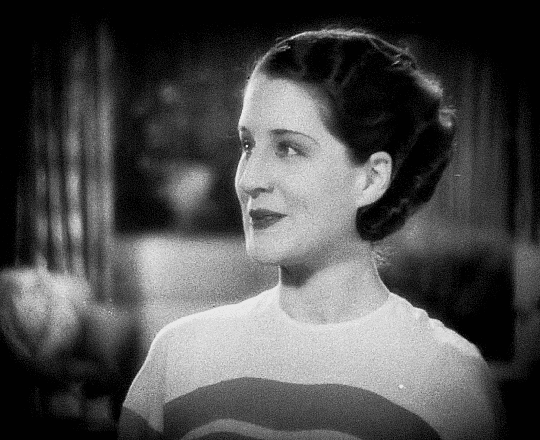ESTA CRÍTICA TEM
SPOILERS
THIS REVIEW HAS SPOILERS
Meu primeiro contato com a obra do diretor alemão Rainer Werner
Fassbinder se deu há mais ou menos dez anos, quando alguns de seus filmes foram
exibidos no Cine Conhecimento do Canal Futura. Da seleção, meu favorito foi seu
último filme, “O Desespero de Veronika Voss” (1982). Eu teria outro encontro
com Fassbinder quando cursei uma disciplina de mestrado e lemos um texto
bem-humorado assinado por ele, e também assistimos à sua obra-prima “Ali: o
Medo Devora a Alma” (1974). Foi uma surpresa que um de seus filmes tenha sido
exibido na TV recentemente, por isso eu o gravei e aqui ei-lo: um dos oito (!) filmes
que ele dirigiu no ano de 1970, “Por Que Deu a Louca no Sr. R?”
My first contact with the works of German director Rainer
Werner Fassbinder was about ten years ago, when some of his films were shown on
a TV program called Cine Conhecimento (Kino Knowledge, in a free but accurate
translation) at the channel Futura. Of the bunch, my favorite was his very last
film, “Veronika Voss” (1982). I would encounter Fassbinder again when I took a
class at a master’s degree program and we read a very humorous text written by
him and later watched his masterpiece “Ali: Fear Eats the Soul” (1974). It was
a surprise that one of his films was shown on TV recently, so I recorded it and
here it is: one of eight (!) films he directed in the year of 1970, “Why Does
Herr R. Run Amok?”
O filme começa com um grupo de quatro amigos
contando piadas. Algumas são engraçadas, outras nem tanto. Um dos amigos, o
único que não contou nenhuma piada, se separa do grupo, virando à esquerda
enquanto os outros seguem à direita. O homem é Herr (Sr.) R. (Kurt Raab), um
desenhista técnico que espera por um novo posto de trabalho. Ele vive em
Munique com sua esposa, Frau (Sra.) R. (Lilith Ungerer), e filho, Amadeus
(Amadeus Fengler).
The film begins with a group of four friends telling jokes.
Some are funny, others not so much. One of the friends, the only who didn’t
tell a single joke, parts from the group, going left while the others go right.
The man is Herr (Mr) R. (Kurt Raab), a draughtsman waiting for a new job
position. He lives in Munich with his wife Frau (Mrs) R. (Lilith Ungerer) and
son, Amadeus (Amadeus Fengler).
Quando estão caminhando pelas ruas, indo a uma
reunião na escola do filho, Frau R. fala sobre uma conhecida que surtou depois
de uma explosão de gás: foi a gota d’água para ela. Durante a reunião, quem fala
é só Frau R., enquanto a câmera foca em Herr R. e podemos vê-lo dissociando da
conversa. Sua gota d’água está próxima.
While they are strolling in the streets, going to a meeting
at their son’s school, Frau R. talks about an acquaintance who freaked out
after a gas explosion: it was her last straw. During the meeting, only Frau R.
speaks, while the camera focuses on Herr R. and we can sense him dissociating.
His last straw is near.
Eu pensei que iria dar a louca em Herr R. durante
um almoço no seu trabalho. Ele fica bêbado e fala sem parar sobre seus colegas,
enfurecendo sua esposa. Então eu percebi: este filme é POR QUE deu a louca no
Sr. R. Vê-lo louco seria a última coisa que veríamos: o filme todo serviria
para nos mostrar as razões.
I first thought that Herr R. would run amok during a
get-together from his work. He gets drunk and talks aimlessly about his
co-workers, making his wife mad. Then I realized: this movie is WHY Herr R. ran
amok. Seeing him running amok would be the last thing we see: the whole movie
would first show us the reasons.
Há alguns momentos muito datados, que são
entretanto divertidos por serem o retrato de uma época. Por exemplo: quando
nosso herói entra numa loja e pergunta sobre uma música que ele ouvira no
domingo passado no rádio. Ele descreve a canção em detalhes, causando riso numa
das vendedoras. Hoje, com aplicativos como Shazam e Spotify, os problemas dele
diminuiriam bastante.
There are very dated moments, that are funny nonetheless for
being the portrait of a time. For instance: when our hero enters a store and
asks about a song he heard that past Sunday in the radio. He describes the song
extensively, causing one of the clerks to laugh. Today, with apps like Shazam
and Spotify, his trouble would diminish a lot.
Outros momentos datados não são tão divertidos.
Quando Amadeus fica brevemente perdido na floresta, a avó do menino culpa a
mãe, Frau R., dizendo que a única missão dela era ficar de olho no garoto. Esta
é a única sequência com a mãe de Herr R., e por isso ela nos parece egoísta e
muito crítica com sua nora.
Other dated moments are not so amusing. When Amadeus gets
briefly lost in the woods, his grandmother blames his mother, Frau R., saying that it was her only duty to
keep an eye on the boy. This is the only bit with Herr R.’s mother, and because
of that she passes to us as being selfish and overly critical of her
daughter-in-law.
Outros momentos são tão frescos que poderiam
ter sido filmados hoje. Um exemplo: uma das amigas de Frau R. conta-lhe que ela
está indo esquiar e alugou uma casinha porque é mais barato que ficar num hotel
– exatamente o tipo de coisa que seria dita pelos defensores do Airbnb! Não é à
toa que é aí que dá a louca no Sr. R!
Other moments are fresh as new. One example: one of Frau R.’s
friends tells her that she is going skiing and rented a little house because
it’s cheaper than staying in a hotel- exactly the kind of thing the defenders
of Airbnb would say! It’s not by chance that it is there that Herr R.
runs amok!
Este filme é assinado por Fassbinder e Michael
Fengler. Entretanto, a atriz Hanna Schygulla, que interpreta rapidamente a personagem
Hanna, declarou que Fassbinder teve pouco a ver com o filme, sendo este feito
quase totalmente por Michael Fengler, uma declaração mais tarde confirmada por
Fengler. Este foi o primeiro filme de Fengler, que mais tarde se dedicou aos
trabalhos como roteirista e produtor.
The film is signed by Fassbinder and Michael Fengler.
However, actress Hanna Schygulla, who plays the character Hanna in a brief
performance, claimed that Fassbinder had little to do with the shooting of the
film, and it was made almost solely by Michael Fengler, a claim later confirmed
by Fengler. This was Fengler’s first film and he later served more as
screenwriter and producer.
Esta não é uma comédia, como o título poderia
nos levar a crer. É um drama, mas não um drama intenso, e muitos podem até chama-lo
de um filme chato. No final das contas, “Por Que Deu a Louca no Sr. R.?” é
sobre os perigos da rotina, ou, como diz o velho ditado: “all work and no play make Jack a dull boy” (“só trabalho e
nenhuma diversão fazem de Jack um garoto sem-graça”).
This is not a comedy, as the title could make us believe.
It’s a drama, but not intense drama, and many could even call it a boring
movie. In the last stance, “Why Does Herr R. Run Amok?” is about the dangers of
routine, or, as the old saying goes: “all work and
no play makes Jack a dull boy”.















